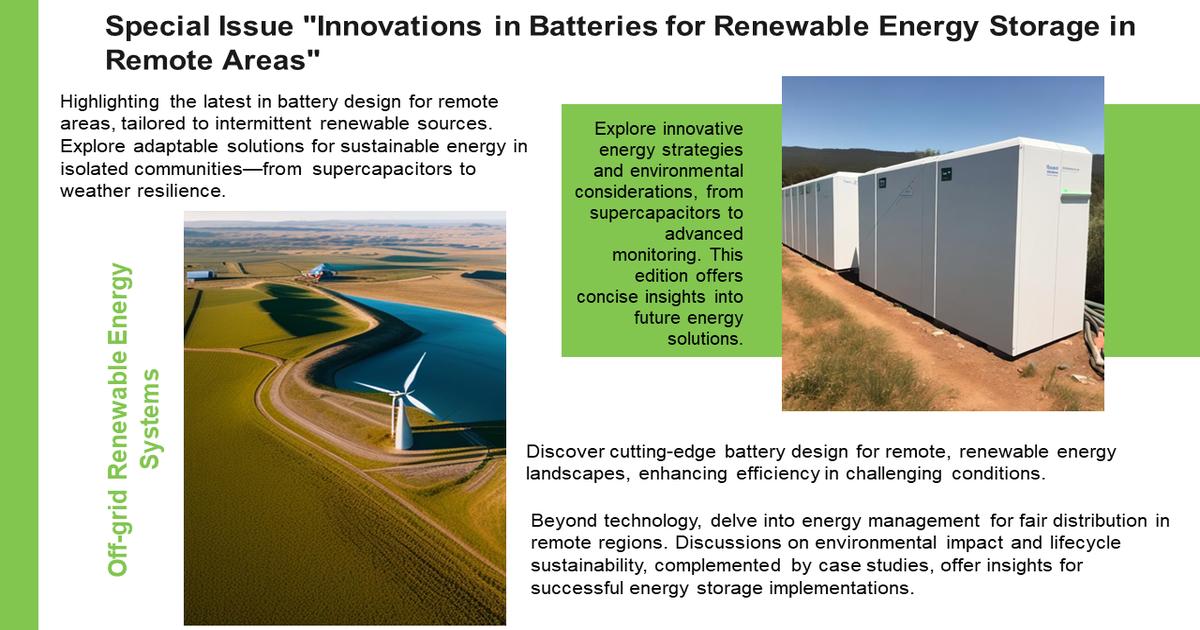Innovations in Batteries for Renewable Energy Storage in Remote Areas
A special issue of Batteries (ISSN 2313-0105). This special issue belongs to the section "Battery Modelling, Simulation, Management and Application".
Deadline for manuscript submissions: 10 July 2024 | Viewed by 140

Special Issue Editors
Interests: advancements in energy storage technologies; innovations in electrical protection systems; power quality enhancement strategies; power smoothing techniques in electrical networks; batteries
Special Issues, Collections and Topics in MDPI journals
Interests: energy/battery management; energy communities; electric vehicles; energy storage; energy systems modeling and optimization; renewable energy
Special Issues, Collections and Topics in MDPI journals
Interests: renewable energy; waste-to-energy; biomass gasification; life cycle assessment
Special Issues, Collections and Topics in MDPI journals
Special Issue Information
Dear Colleagues,
This Special Issue presents a comprehensive exploration of recent innovations in battery design, specifically tailored to the unique energy storage requirements of remote areas characterized by intermittent renewable sources. The primary focus of this Special Issue is to delve into the adaptability of batteries to the varying energy conditions inherent in sources such as solar and wind. Emphasis is placed on strategies and technologies aimed at enhancing the integration of batteries with other storage mechanisms, including supercapacitors, while ensuring their resilience and durability in the face of extreme weather conditions.
Moving beyond technical considerations, this Special Issue scrutinizes innovative energy management strategies that go hand-in-hand with ensuring a fair and efficient distribution of energy in remote communities. The environmental impact of batteries deployed in isolated areas takes center stage, prompting discussions on approaches to improve sustainability throughout the entire lifecycle of these energy storage systems. This Special Issue also features a comprehensive review of monitoring technologies, complemented by insightful case studies that showcase successful energy storage implementations in diverse remote communities.
By providing a holistic view of these advancements, this Special Issue aspires to be a pivotal resource for researchers, scientists, and engineers actively engaged in developing practical and sustainable energy solutions tailored to the unique challenges posed by remote environments.
Dr. Paul Arévalo
Dr. Marcos Tostado-Véliz
Prof. Dr. David Vera Candeas
Dr. Roque Aguado Molina
Guest Editors
Manuscript Submission Information
Manuscripts should be submitted online at www.mdpi.com by registering and logging in to this website. Once you are registered, click here to go to the submission form. Manuscripts can be submitted until the deadline. All submissions that pass pre-check are peer-reviewed. Accepted papers will be published continuously in the journal (as soon as accepted) and will be listed together on the special issue website. Research articles, review articles as well as short communications are invited. For planned papers, a title and short abstract (about 100 words) can be sent to the Editorial Office for announcement on this website.
Submitted manuscripts should not have been published previously, nor be under consideration for publication elsewhere (except conference proceedings papers). All manuscripts are thoroughly refereed through a single-blind peer-review process. A guide for authors and other relevant information for submission of manuscripts is available on the Instructions for Authors page. Batteries is an international peer-reviewed open access monthly journal published by MDPI.
Please visit the Instructions for Authors page before submitting a manuscript. The Article Processing Charge (APC) for publication in this open access journal is 2700 CHF (Swiss Francs). Submitted papers should be well formatted and use good English. Authors may use MDPI's English editing service prior to publication or during author revisions.
Keywords
- battery design innovations
- remote energy storage
- intermittent renewable sources
- energy integration strategies
- resilient battery technologies
- sustainable energy solutions
Planned Papers
The below list represents only planned manuscripts. Some of these manuscripts have not been received by the Editorial Office yet. Papers submitted to MDPI journals are subject to peer-review.
Title: Electrode blending simulations Using the Mechanistic Modeling Approach
Authors: David Beck; Matthieu Dubarry
Affiliation: University of Hawaiʻi at Mānoa / Hawaiʻi Natural Energy Institute
Abstract: Blended electrodes are becoming increasingly more popular in lithium-ion batteries, yet most modeling approaches are still lacking the ability to separate the blend components. This is problematic because the different components are not likely to degrade at the same pace. This work investigated a new approach towards the simulation of blended electrodes by replicating the complex current distributions within the electrodes using a paralleling model rather than the traditional constant current method. In addition, a blending model was used to generate three publicly available datasets with more than 250,000 unique degradations for three exemplary blended cells. These datasets allowed to showcase the necessity of considering all active components of the blend separately for diagnosis.








